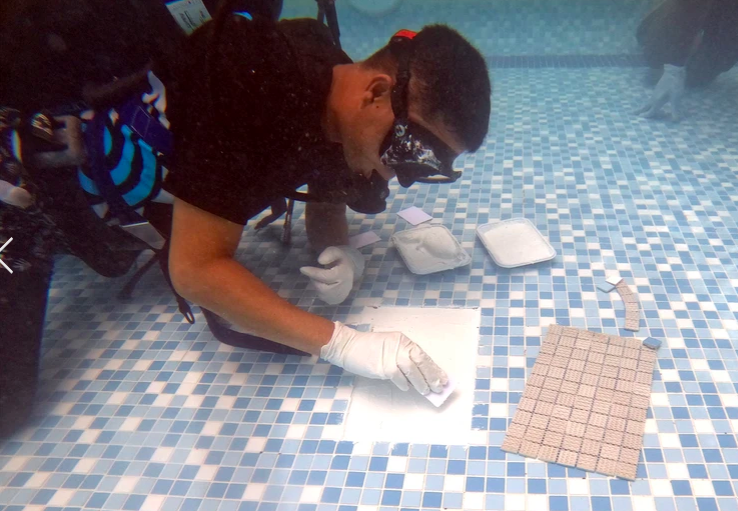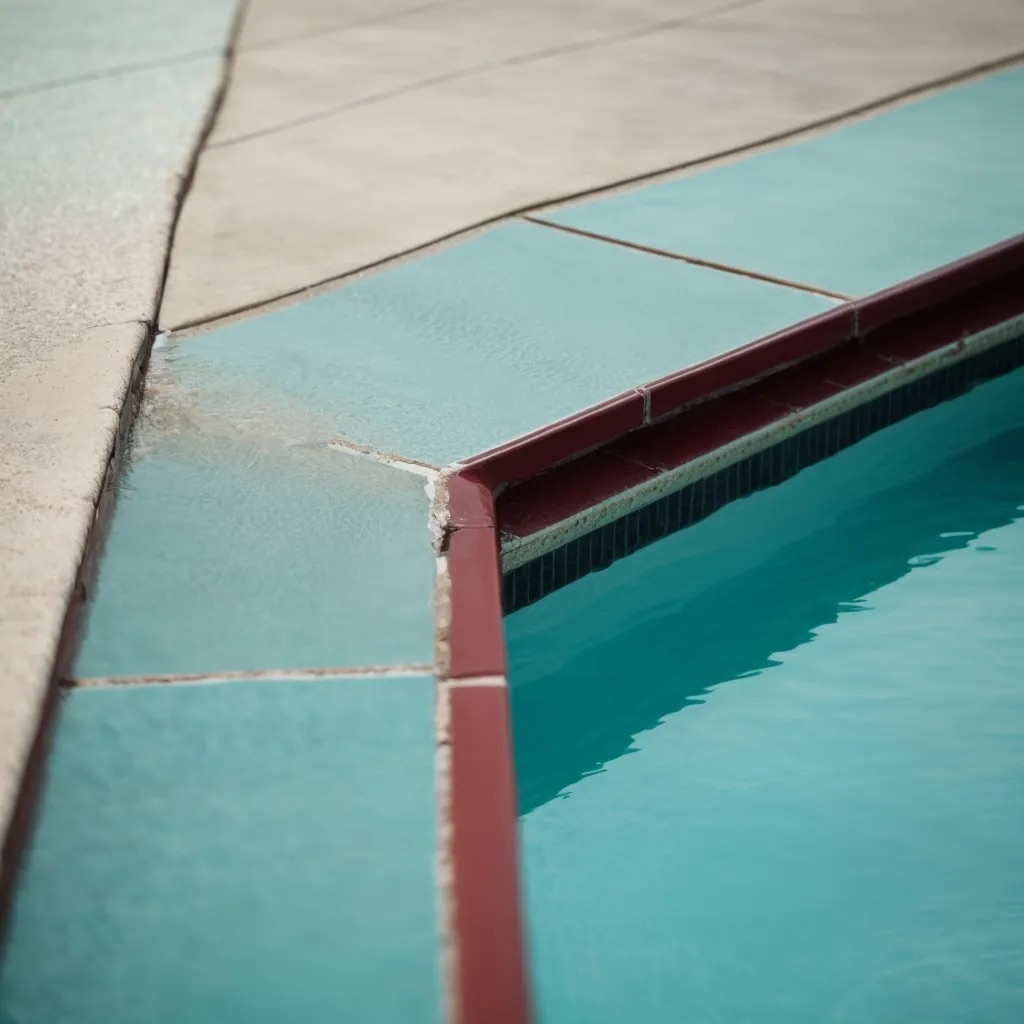Are you tired of dealing with cracked, loose, or damaged pool tiles? Look no further! We’re here to provide you with swift and effective solutions to fix your pool tiles underwater.
At our company, we understand the importance of maintaining a pristine and beautiful pool. That’s why we offer a wide range of services to address any tile-related issues you may have. Whether it’s pool tile cleaning, repair, or replacement, we’ve got you covered.
Give us a call today and let us fix your pool tiles underwater, leaving your pool looking as good as new.
Common Causes of Underwater Pool Tile Damage
One of the most common causes of underwater pool tile damage is due to improper installation or adhesive failure. Improper installation can lead to tiles becoming loose or even falling off completely. This not only affects the aesthetics of our pool but also poses a safety risk, as loose tiles can cause cuts or injuries. Adhesive failure is another common cause of underwater pool tile damage. If the adhesive used to secure the tiles isn’t strong enough or is applied incorrectly, it can result in tiles becoming dislodged or cracked. This can happen over time due to wear and tear, or it can occur suddenly due to external factors such as extreme weather conditions or heavy usage.
To ensure the longevity and beauty of our pool tiles, it’s essential to have them installed by professionals who understand the proper techniques and use high-quality adhesive. By doing so, we can create a pool environment that not only provides a sense of belonging but also withstands the test of time.
Tools and Materials Needed for Underwater Pool Tile Repair
We will need a few essential tools and materials for our underwater pool tile repair. Having the right equipment will ensure that we can complete the job efficiently and effectively. Here are the tools and materials that we’ll need:
- Scuba Gear: To perform underwater pool tile repair, we’ll need scuba gear to allow us to work comfortably and safely underwater. This includes a wetsuit, diving mask, snorkel, and fins.
- Tile Adhesive: We’ll need a high-quality tile adhesive specifically designed for underwater use. This adhesive will ensure that the tiles bond securely to the pool surface and can withstand the water pressure.
- Grout: A waterproof grout is essential for filling in the gaps between the tiles. This will help to seal the tiles and prevent water from seeping in behind them.
- Tile Cleaning Solution: Before repairing the tiles, it’s important to clean them thoroughly. A pool tile cleaning solution will help to remove any dirt, grime, or algae that may be present.
- Tile Repair Kit: A tile repair kit will contain various tools such as a grout float, trowel, and sponge that are specifically designed for tile repair. These tools will help us to efficiently repair the damaged tiles.
- Safety Equipment: Safety should always be a priority when working underwater. We’ll need safety goggles, gloves, and knee pads to protect ourselves during the repair process.
Step-by-Step Guide to Removing and Replacing Pool Tiles Underwater
Before we begin removing and replacing pool tiles underwater, let’s ensure that we’ve all the necessary tools and materials ready. This step-by-step guide will help us navigate the process smoothly and efficiently.
First, we need to drain the pool to a level below the tiles we’re planning to replace. This will allow us to work comfortably underwater. Once the water level is lowered, we can start inspecting the tiles to identify the ones that need to be removed.
Using a chisel or a tile removal tool, gently pry the damaged tile away from the pool wall. Be careful not to damage the surrounding tiles. If the tile is stubborn, applying heat to it with a heat gun can help loosen the adhesive.
Once the old tile is removed, it’s time to prepare the surface for the new tile. Use a wire brush to clean the area and remove any remaining adhesive. Make sure the surface is smooth and dry before proceeding.
Apply a thin layer of tile adhesive to the back of the new tile and press it firmly onto the prepared surface. Hold it in place for a few seconds to ensure proper adhesion. Repeat this process for each tile that needs to be replaced.
After all the new tiles are in place, give them enough time to dry and set. Once they’re secure, we can refill the pool with water and enjoy our newly replaced tiles.
Remember, safety is paramount when working underwater. Always wear goggles and gloves to protect yourself from any potential hazards.
## Tips for Properly Sealing and Grouting Pool Tiles Underwater
Let’s explore some helpful tips for ensuring the proper sealing and grouting of pool tiles underwater.
When it comes to sealing pool tiles underwater, it’s important to use a high-quality, waterproof sealant. This will help to prevent water from seeping behind the tiles and causing damage. Before applying the sealant, it’s essential to thoroughly clean the tiles and remove any dirt or debris. This can be done using a mild detergent and a soft brush. Once the tiles are clean, the sealant can be applied using a caulking gun. It’s important to apply a generous amount of sealant and ensure that it’s evenly spread across the tiles. After the sealant has been applied, it’s important to allow it to dry completely before allowing any water to come into contact with the tiles.
When it comes to grouting pool tiles underwater, it’s important to use a waterproof grout. This will help to prevent water from seeping behind the tiles and causing damage. Before applying the grout, it’s essential to clean the tiles and remove any dirt or debris. Once the tiles are clean, the grout can be applied using a grout float. It’s important to press the grout firmly into the gaps between the tiles to ensure a strong bond. After the grout has been applied, it’s important to wipe away any excess grout using a damp sponge. This will help to create a smooth and even finish. It’s important to allow the grout to dry completely before allowing any water to come into contact with the tiles.
Maintenance and Prevention Strategies to Avoid Future Pool Tile Damage
Our team recommends implementing regular maintenance and prevention strategies to avoid future pool tile damage.
Taking proactive measures can help extend the lifespan of your pool tiles and save you from costly repairs in the future. One important maintenance strategy is to regularly clean your pool tiles to prevent the buildup of dirt, debris, and algae. This can be done using eco-friendly and chemical-free cleaning methods, such as pool bead blasting or glass bead blasting. By keeping your tiles clean, you can prevent the growth of algae and reduce the risk of tile deterioration.
Another important prevention strategy is to address any issues promptly. If you notice any broken or loose tiles, it’s crucial to get them repaired as soon as possible. Ignoring these small damages can lead to bigger problems down the line, such as water infiltration and further tile damage. Additionally, regular inspection and maintenance of the pool tile grout is essential. Over time, grout can deteriorate, allowing water to seep behind the tiles and cause them to become loose or fall off. By addressing grout deterioration early on, you can prevent more extensive damage to your pool tiles.
Furthermore, it’s important to consider the quality of the materials used for pool tile installation and replacement. Opting for high-quality tiles and proper adhesion using new thin set can significantly improve the durability and longevity of your pool tiles. Drainage of the pool and proper preparation of the tile bed before replacement is also crucial in ensuring a successful installation.
Key Takeaways
– Pool tile repair services include prompt repairs for broken or loose tiles, addressing grout deterioration, and timely repairs to prevent further damage.
– Pool tile replacement services offer reliable replacement of cracked, damaged, or fallen-off tiles, addressing the cause of tile failure before replacement, and professional installation with proper adhesion using new thin sets.
– Pool acid wash is an effective solution for difficult stains and algae growth, involving the stripping of a thin layer of plaster to expose fresh plaster and the removal of algae and contaminants from the plaster, resulting in a dramatic improvement in pool appearance.
– Pool chlorine bath is a suitable solution for noticeable algae buildup, involving the application of a liquid chlorine mixture to affected surfaces, scrubbing to work chlorine into the pores, and a rinse and repeat process for thorough cleaning, especially suitable for pebble pools and serious algae issues.





